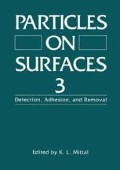Abstract
Despite the advancement of dry processing in ULSI manufacturing, wet chemical cleaning remains the only reliable method for controlling particulate contamination on semiconductor wafer surfaces.
It is necessary to accurately measure the number of particles in all liquid chemicals and understand the mechanisms of particulate adhesion so that this form of contamination may be minimized on silicon surfaces. We believe that the particle concentration and zeta potential, and the condition of the wafer surface are all factors which determine the number of particles which deposit on surfaces immersed in liquids.
A new laser particle counter, the Horiba PLCA 520, with specifications for detecting particles to 0.2 μm in chemicals was used in this study. This particle counter is unique in its ability to use either pressure or suction fluid sampling. Thus, the question of whether particle counts are inflated through the inclusion of bubbles during suction sampling may be addressed. No appreciable difference between suction and pressure sampling was found, with two exceptions: nitric acid and ammonium hydroxide. Calibration tests, as well as pressure/suction sampling characterizations of common ULSI-grade processing chemicals are presented.
We have demonstrated that particles adhere to bare silicon wafers in proportion to their zeta potential and concentration in liquids. Furthermore, it is shown that the number of particles deposited in acidic and alkaline solutions are quite different, in keeping with published data on zeta potentials as a function of solution pH.
Access this chapter
Tax calculation will be finalised at checkout
Purchases are for personal use only
Preview
Unable to display preview. Download preview PDF.
References
K. L. Mittal, editor “Particles in Gasses and Liquids 1: Detection, Characterization and Control”, Plenum Press, New York (1989)
L. D. Michaels. V. B. Menon, R. P. Donovan and D. S. Ensor, Particle Deposition at the Solid-Liquid Interface, Proceedings, 34th Annual Technical Meeting of the Institute of Environmental Sciences, 438–442 (1988)
H. Mishima, T. Yasui, T. Mizuniwa, M. Abe and T. Ohmi, Particle-Free Wafer Cleaning and Drying Technology, IEEE Trans. on Semiconductor Manufacturing, 2 No. 3, 69–75 (August, 1989)
A. Saito, K. Ohta, M. Watanabe and H. Oka, Particle Deposition Mechanism onto Silicon Wafer, Extended Abstract of the 21st Conference on Solid State Devices and Materials, (409–412), Tokyo, Japan (August, 1989).
T. Niida, Controlling for Particle Adhesion in Liquids — a Basic Way of Thinking, Chemical Engineering Institute of Japan, Kansai Branch, Osaka, Japan 14–25, (September, 1989)
D. J. Riley and R. G. Carbonell. The Deposition of Liquid-Based Contaminants onto Silicon Surfaces Proceedings, 36th Annual Technical Meeting of the Institute of Environmental Sciences, 224–228 (1990)
A. W. Adamson, “Physical Chemistry of Surfaces, 4th Edition”, John Wiley & Sons, New York (1982)
D. W. Cooper, Statistical Analysis Relating to Recent Federal Standard 209 (Cleanrooms) Revisions, J. Environ. Sci. 31 No. 5, 48–52 (1988)
Robert K.Perry and C.H. Chilton, “Chemical Engineers’ Handbook”, 5th ed., pp. 3–68, McGraw Hill Book Company, New York (1973)
Y. Kasama, Y. Yagi, T. Imaoka, M. Kawakami and T. Ohmi, Advanced DI Water System with Low Dissolved Oxygen for ULSI Processing, Proceedings, 36th Annual Technical Meeting of the Institute of Environmental Sciences, 344–349 (1990)
T. Ohmi, Future Trends and Applications of Ultra-clean Technologies, Technical Digest, International Electron Device Meeting, Washington, D.C. (1989)
T. Ohmi, Ultra-clean Technology: ULSI Processing’s Crucial Factor, Microcontamination, 6, No. 10, pp. 49–58 (October, 1988)
Author information
Authors and Affiliations
Editor information
Editors and Affiliations
Rights and permissions
Copyright information
© 1991 Springer Science+Business Media New York
About this chapter
Cite this chapter
Itano, M. et al. (1991). Particles in Ulsi Grade Chemicals and Their Adhesion to Silicon Surfaces. In: Mittal, K.L. (eds) Particles on Surfaces 3. Springer, Boston, MA. https://doi.org/10.1007/978-1-4899-2367-7_4
Download citation
DOI: https://doi.org/10.1007/978-1-4899-2367-7_4
Publisher Name: Springer, Boston, MA
Print ISBN: 978-1-4899-2369-1
Online ISBN: 978-1-4899-2367-7
eBook Packages: Springer Book Archive

